Just Filled the Pool With Water, Now What?
Author: Chris Miller | Editor: Omar Alonso
Review & Research: Jen Worst & Chris Miller
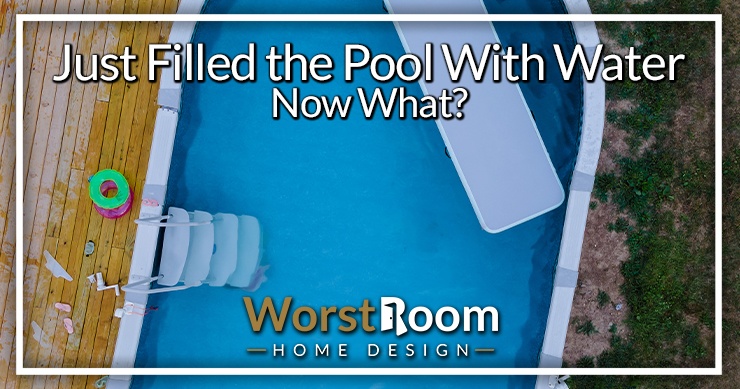
Congratulations on filling your swimming pool with water! Now, you might be wondering what comes next to ensure that your pool is safe, clean, and ready for use. You just filled the pool with water, now what?
Here we'll guide you through the essential steps of maintaining proper water chemistry, keeping your pool clean, and setting up the necessary equipment. We'll also touch upon wildlife protection and community development efforts surrounding swimming pools.
What to Do After Filling a Pool With Water
After filling your pool with water, the first step is to test its chemistry by checking the pH, alkalinity, and chlorine levels to ensure they are within safe ranges.
Testing Water Chemistry: PH, Alkalinity, & Chlorine Levels
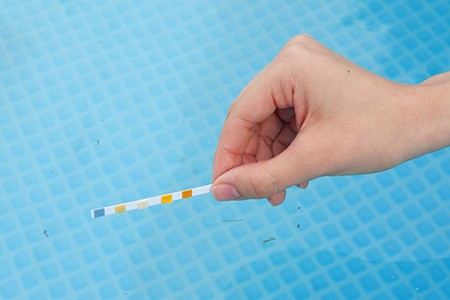
First you need to know what to put in a pool after filling it. Maintaining balanced water chemistry is essential for a healthy and enjoyable pool experience. Testing the pH, alkalinity, and chlorine levels should become a regular part of your pool maintenance routine.
A correct balance of alkalinity (100 to 150 parts per million) works hand-in-hand with pH to provide stability in your pool water by buffering against sudden changes in acidity that can result from rainwater or other external factors.
At the same time, adequate chlorine levels (between one and three PPM) serve as a powerful disinfectant that combats harmful bacteria growth while keeping algae at bay. You can also look into pool chlorine alternatives with their own target levels.
How Soon After Filling a Pool Can You Swim?
You just filled the pool with water, now what? How long after shocking a pool can you swim? The general rule of thumb is to wait 24 hours (a full day) before you take a dive in your newly shocked and chlorine cleaned pool water. You want the chlorine levels to drop to 5 parts per million or less before you enter the pool.
Checking For Pool Leaks
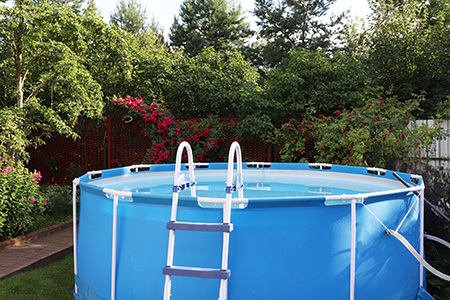
After filling your pool with water, one crucial step to take is checking for leaks. A leak can cause significant water loss and even damage the surrounding area, making it essential to identify and fix any issues early on.
To begin this process, examine your pool's structure, such as the walls and floor, for any visible cracks or holes.
There are also more subtle indicators that may point towards a leak in your swimming pool system. For instance, observing rising water bills without a corresponding increase in usage might suggest an undetected leaking problem.
In addition to visual inspection, consider using dye tests near suspicious spots where escaping water might draw the dye outdoors. Another method involves monitoring the water level over 24 hours while both running and not running filtration systems; if there’s a discrepancy in levels during these periods, you likely have a plumbing issue at hand.
Setting Up Pool Equipment
After filling your pool with water, one of the critical steps in preparing it for use is setting up the proper pool equipment. Start by installing a reliable and efficient filtration system, which will help remove debris and maintain water clarity.
Next, set up essential items such as skimmers or automatic pool cleaners to keep your pool free from floating debris like leaves and insects. Additionally, invest in a quality water testing kit to monitor pH levels, calcium hardness, total alkalinity, and chlorine concentration regularly. Keeping these levels within recommended ranges ensures optimal water quality for safe swimming.
Maintaining Proper Water Chemistry
Regularly monitoring and balancing the pH, alkalinity, and chlorine levels using appropriate chemicals is crucial to ensure clean and safe swimming pool water.
Understanding the Ideal PH, Alkalinity, & Chlorine Levels
Maintaining proper water chemistry in your pool is essential for a safe and enjoyable swimming experience. The ideal pH level for pool water should be between 7.4 and 7.6, indicating a slightly basic or neutral environment.
Too acidic, and the water can damage equipment, irritate skin or eyes, and corrode surfaces like tiles or liners. Alkalinity is another significant factor to consider when testing your pool's water chemistry; it should range from 100 to 150 parts per million (PPM).
If alkalinity levels are too low, the pH balance will become unstable; if it's too high, chlorine effectiveness may diminish.
Total alkalinity plays an important role in maintaining pool water balance as well since it measures the amount of bicarbonates present in the water responsible for buffering changes in pH levels.
Ideally ranging from 80 -120 ppm for concrete pools or fiberglass pools and about 125-170ppm on vinyl liner pools with stabilizers known as CYA optimal at around thirty to fifty parts per million (PPM).
Monitoring Water Chemistry Regularly
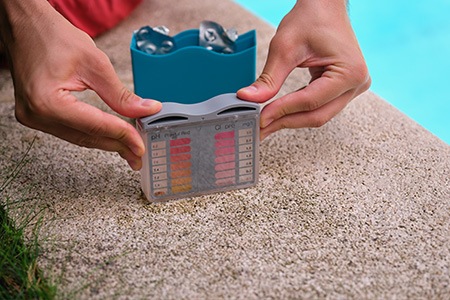
Regularly monitoring your pool's water chemistry is essential to maintaining a safe and healthy swimming environment. Testing the pH level, alkalinity levels, chlorine concentration, CYA levels, and calcium hardness measurement should be done at least once a week.
It's important to understand that even small changes in chemical balance can affect water quality significantly. For example, high temperatures or heavy rainfall may cause chemicals to break down faster than usual and require more attention to maintain proper balance.
Without regular testing and maintenance of your pool's water chemistry, the risks of bacteria growth increase dramatically.
Using Appropriate Chemicals to Balance Levels
Maintaining proper water chemistry is essential to keep your pool safe and clean for swimming. One of the key components of this is using appropriate chemicals to balance levels.
Depending on your pool's needs, you may need to add chemicals such as pH increaser or decreaser, calcium hardness increaser, chlorine stabilizer (CYA), algaecide, and shock treatment.
It's important to follow the instructions when adding these chemicals and not mix them together.
To ensure that you're using the right amount of chemicals, it's crucial to test your water regularly with a reliable testing kit. This will help you determine which levels are low or high in your pool so that you can adjust accordingly.
Keeping Your Pool Clean & Maintained
You just filled the pool with water, now what? You're already thinking about the cleaning chores and schedules and the maintenance procedures you'll be undertaking.
Regularly skimming the surface of the pool to remove debris and using a pool brush or vacuum to clean the walls and floor prevents algae growth, extends the life of your filtration system, and helps keep your pool water clear.
Skimming The Surface For Debris
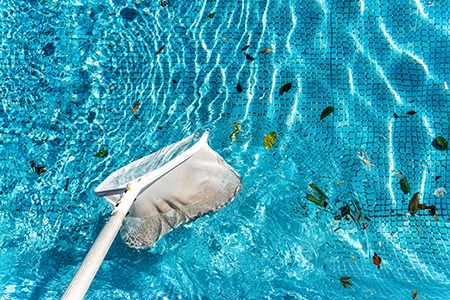
One of the most critical tasks in keeping your pool clean and maintained is skimming the surface for debris. This involves using a handheld skimmer or net to remove leaves, insects, and other foreign objects from the water's surface.
Skimming regularly not only keeps your pool looking inviting but also helps prevent clogging of the filter system.
It's particularly important to skim before treating your pool with chemicals as this will help ensure that any contaminants on top are removed first. Neglecting this task can mean that more significant problems arise later on, such as clogged filters or even bacteria growth.
Brushing & Vacuuming the Pool Walls & Floor Regularly
Regularly cleaning the walls and floor of your pool is crucial for maintaining its cleanliness and overall health. Brushing the walls and vacuuming the floor will help to remove any debris or materials that have settled on the surface of your pool.
To ensure you don't forget to do this regularly, it's best to make a schedule for this task. You can devise one based on how often you use the pool, but typically once a week is ideal.
Remember that brushing should be done before vacuuming as dirt lifted from brushing may settle at the bottom if not removed by vacuuming immediately afterward.
Backwashing or Cleaning the Filter as Needed
It is essential to maintain a clean and healthy pool, which is why it's crucial to backwash or clean the filter as needed. The pool filter plays a vital role in removing impurities from the water, so keeping it functioning effectively is critical.
To backwash your filter correctly, start by turning off your pump and closing all valves leading to it. Then select “backwash” mode on your pool’s multiport valve and turn the pump back on for about three minutes or until clear water appears through the sight glass.
It's important not just test regularly but also have an understanding of what those results mean when maintaining proper water chemistry.
Shocking the Pool to Eliminate Bacteria & Other Contaminants
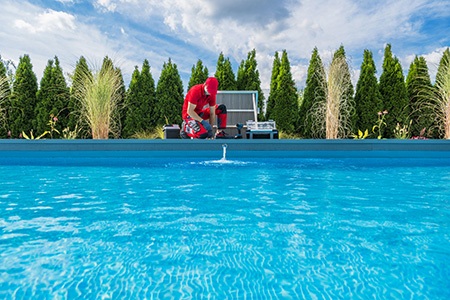
Regular maintenance and cleaning can keep your pool water healthy, but sometimes you may need an extra boost to eliminate bacteria and other contaminants. This is where "shocking" your pool comes in handy.
Shocking a pool involves adding a large dose of chlorine or non-chlorine shock treatment to the water to kill off any bacteria that regular chlorine levels cannot handle.
It's essential to remember that shocking should only be done when necessary as it can affect the overall chemistry of your pool water.
Following proper guidelines while shocking and testing levels regularly ensures crystal clear water free from harmful elements, making sure everyone who swims in it remains safe and happy all season long!
Key Takeaways For After Filling Your Pool
- After filling your pool with water, it's important to test the pH, alkalinity, and chlorine levels regularly for a safe and healthy swimming environment.
- Keeping the pool clean by skimming debris, brushing/vacuuming walls/floor, and backwashing/cleaning filters is essential in maintaining optimal water quality.
- Using appropriate chemicals to balance pH levels including calcium hardness increaser or reducer, chlorine stabilizer (CYA), algaecide will help maintain proper water chemistry. Regular testing kits are necessary to determine correct chemical application.
- Shocking should only be done when necessary as it can affect overall chemistry of pool water.
That’s What to Do After Adding Water to Your Pool
Congratulations on filling your pool with water! Now that you have taken the first step, it's crucial to prepare and maintain your pool properly. Remember to test pH, alkalinity, and chlorine levels regularly and be vigilant for any leaks or equipment malfunctions.
Pool hygiene is critical in ensuring a safe and healthy environment for all swimmers. Regular cleaning, vacuuming, and backwashing of filters will keep bacteria and contaminants at bay.
By following these simple steps outlined above, you can enjoy clean crystal-clear water every time you take a dip! You just filled the pool with water, now what? You've got all the info you need. You could write it down on an index card and store it in your pool house or garage so you'll know each summer.



